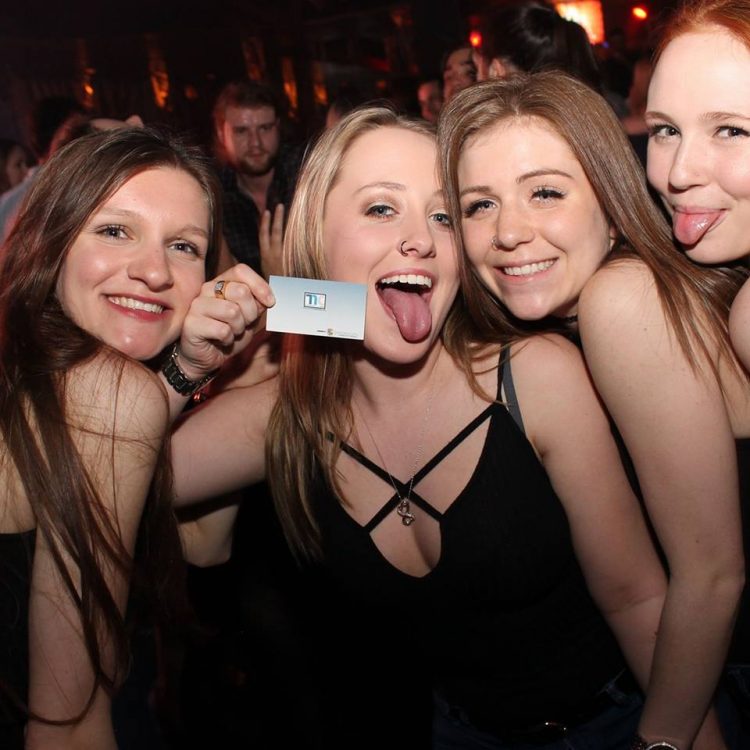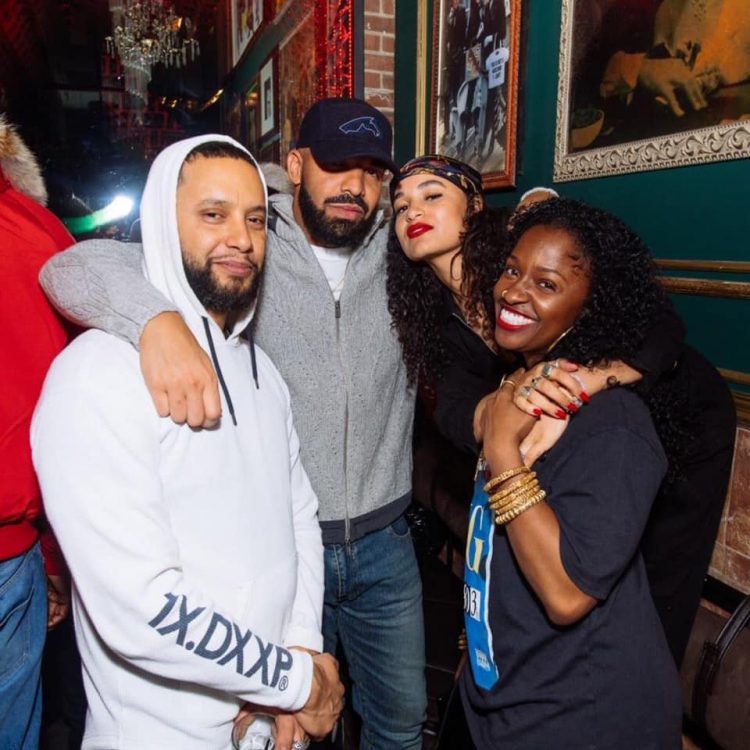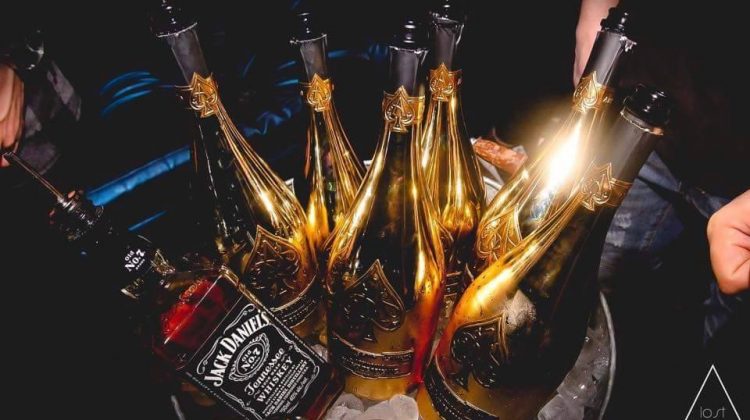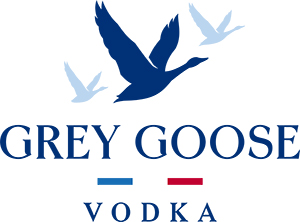The nightclub pulsed in the Miami heat. Dancers waved glow sticks with neon letters spelling out “F*** me I’m famous”. The millionaire was dressed in a black t-shirt and jeans, and would have been easy to miss if he hadn’t been surrounded by a dozen tall, thin, beautiful women and waving a pink bottle of Cristal champagne. His next drinks order arrived in a ceremonial procession, known in the nightclub business as a bottle train. A group of bouncers carried two bins full of champagne bottles and sparklers, lifted high above their heads. They were followed by a procession of stiletto-clad waitresses, bearing the same gifts.
Onlookers cheered in the glow and held up their phones to take pictures. A man standing next to me looked blasé at the unfolding scene and offered me a swig from his own champagne bottle: a 2004 Cristal rosé.
“How much does this cost?” I asked him, gesturing at the bottle.
He told me it was $1,700. I watched as the millionaire shoved his bottle towards the face of a nearby model, causing the expensive liquid to foam wastefully over the neck.
We’ve all seen scenes like this on Instagram or the pages of glossy magazines. Over the last few decades, a new elite has emerged, partly as a result of deregulation of the financial sector in the West and partly because of the spread of global capitalism across the world. This elite is more geographically dispersed and mobile than the aristocrats and capitalists of yesteryear. And an industry has sprung up to feed it.
A small cohort of oligarchs, New York hedge-fund managers and Silicon Valley investors now patronise a network of nightclubs that span the globe. Whether they’re in Miami or St Tropez these clubs tend to have similar decor and the same clientele. The coronavirus pandemic has temporarily paused the partying, but you can be sure that this sector of society, locked down in large homes and insulated from the economic recession, will soon be up for a good time again.
The visual tropes of this world are familiar even to non-vips: angular cheekbones, Louboutin heels, sprays of champagne. What most people don’t realise is that the apparently spontaneous abandon of those extravagant nights is, in fact, painstakingly planned. It takes a carefully hidden, intricate economy, based on a complex brokering of beauty and status, to create an atmosphere in which people will spend $100,000 on alcohol in a single night. This economy’s currency is young women. The leggy blondes who surrounded the millionaire that night in Miami were not there by chance.
I went behind the scenes in this world between 2010 and 2014, trying to establish how it worked. Because I was a model before I became a sociologist, I was able to enter roped-off areas that ruthlessly exclude any woman who does not conform to a certain body type. I talked to the young women who surrounded the millionaires and came to understand that, whether they fully acknowledged it or not, they were being managed: shunted in and out of nightclubs with brisk efficiency. Women in this world were living props in a carefully scripted theatre that created real financial value for men – the promoters who set up the scene, the nightclub-owners who raked in the bar bills, the wannabe billionaires who used the environment to network. The women’s motivation was harder to pinpoint. But every night they gamely donned their heels and hit the clubs. The show had to go on.
Dre was a promoter for some of the biggest clubs on the vip circuit (like others in this story he asked me to use a pseudonym). He was a handsome 38-year-old with a shaved head and dazzling smile, whose job was to encourage big spenders to book tables at the clubs he worked for. He achieved this partly through his own charisma. He’d dabbled in the music business before becoming a promoter (at a certain point in the night he performed an unforgettable rendition of Michael Jackson’s “Billy Jean”), and was the kind of person celebrities liked to greet on a night out. But Dre’s main talent was his ability to bring in models, ideally at least five a night (other promoters aimed for ten – it was important for there to be an excess of beauty). “I know how to talk to girls,” Dre often said. “They like me.”
Through spending a lot of time with Dre in New York, I learned the basic economics of the system that he worked so effectively. In some ways Dre’s job resembled that of a pimp but, like every promoter, he flinched when I raised the idea. Some of the rich nightclub customers may have had sex with the beautiful women rustled up for them by promoters, though I didn’t see much evidence of this (often the men hardly spoke to them). But fundamentally that was not the reason the women were there. The point of gathering a crowd of models was to put customers in the right kind of mood to spend money. Dre’s ultimate client was the club-owner, who transformed that ambience into profit by inflating the price of the alcohol they bought by up to 1,000%. That mark-up included the invisible labour it took to summon the models. Customers paid so they didn’t have to bring the women themselves or engage a broker to procure them. They paid for the illusion of spontaneity.
Dre had a gift for creating a relaxed atmosphere in fancy places. I watched him at work in a famous restaurant in SoHo, where the owner was paying him at least $1,000 a night to bring in the right crowd. He sat flanked by bottles and beautiful women, apparently kicking back but in reality watching the room like a hawk. “Ça va?” he said as an acquaintance passed by in a sharp suit. Dre stood up to shake hands and chat. When he sat back down he whispered in my ear, “That guy’s from a Saudi family. A billionaire.” He winked to a woman sitting at the restaurant bar, supposedly the princess of a small country known for its offshore banks. As another man approached the table, Dre whispered, “He’s really rich, his family. Really rich.” Dre gave him a playful shoulder punch and fist bump. “A girlfriend of mine asked if there are any hot guys here tonight,” he said, followed by a calculated pause. “I said ‘yes’ when I saw you walk in!”
Clubs gave Dre and other promoters a nightly fee to bring in someone, almost always a man, willing to book a table and buy bottles of wine. Clubs usually gave the promoter a cut of the client’s bar bill too, around 10-20%. It wasn’t exactly easy money – the paternalistic relationship between promoters and models involves a lot of taxi fares, meals and gifts, totalling hundreds of dollars a day, and clubs are famously slow in processing payments. But in a good year, Dre took home $200,000.
Customers called Dre when they wanted to have a good time – in practical terms, a guaranteed table at the coolest club, surrounded by the best-looking women – and he wanted them to think of him as a friend. He was always on the hunt for wealthy men to add to his phone contacts, or, better still, a “whale”. Whales, men willing to drop a house deposit’s worth of cash in one night, were the most sought after prize of the vip nightclub economy. During my time on the scene, Jho Low, a Malaysian financier, was the biggest fish of all (Interpol later issued a red notice for his alleged role in a multibillion-dollar fraud.) “He spends $1m wherever he goes,” one promoter told me.
These big beasts were rarely spotted. But the possibility that they might turn up was part of the appeal for the much larger number of clients in the tier of wealth below them. Most of Dre’s business came from more run-of-the-mill bankers, tech developers and other high-earning professionals, whose bar bills were a fraction of the whales’, but would still seem eye-watering to rest of us. One club-owner referred to this section of his clientele as “the lettuce”: “It’s like making a salad. What’s the most important ingredient, the biggest ingredient? Lettuce. That’s our affluent New Yorkers, guys with small bills of three to five thousand.”
If you were to ask most people what makes men spend thousands of dollars on alcohol in a single night, the answer would probably seem simple. Rich people like showing off and don’t care about losing money. But even among the very rich there are taboos around gratuitous spending. The people I interviewed who frequented such bars, and spent these large sums, often used the same words to describe the rituals of nightclub extravagance: “ridiculous”, “stupid”, “waste” and “crazy”. For the alchemy by which money is turned into status – to persuade people to break these taboos, in other words – there had to be the right audience. And that’s why the models had to be there.

One promoter explained the effect of these women to me. “A model is a model. She goes into a club, and she’s, like, flashlight. And the guys next to her, they’ll be like, ‘Damn, this club is hot. Get me another bottle.’”
To achieve this effect, the women brought in by the promoters either had to be models or have similar physical attributes: beauty, height and thinness. Non-models with the right appearance were sometimes part of the entourage, but they stood a notch lower down in the caste system, referred to as “good civilians”. Unlike the waitresses, who tended to be more voluptuous, the job of the women the promoters brought in was not primarily to appeal to men’s sexual fantasies but to represent the most aspirational version of femininity. Promoters told me in all seriousness that letting in women who were merely slim rather than thin could really damage a club’s reputation.
Club-owners transform ambience into profit by inflating the price of the alcohol by up to 1,000%
The spending sprees which the promoters’ women stimulated were not necessarily motivated by a desire to impress them. I came to realise that such gestures were often directed at other rich male customers. One club-goer told me about a “bottle Olympics” between two customers from India and Pakistan that he witnessed one night, each striving to outdo the other in ordering rare bottles of champagne. A backdrop of beautiful women facilitated such primitive battles. Status is a sensitive thing. It exists only when an audience recognises it: it cannot be bought outright without a loss of status. This means that vip clubs have to construct an environment which makes status-seeking seem the by-product of a fun and spontaneous night out. “Each night is a production,” one promoter told me. “It’s a show.”
Unlike the club-owners and promoters, the young women weren’t getting any money for their work. Those I spoke to were at pains to dissociate themselves from any such arrangement, describing women who sought to monetise their attractiveness by hooking a rich boyfriend as “sluts” or “bitches”. So why did they follow promoters like Dre into the clubs, night after night? Even after living among them for months, it took me time to work it out.
Perks were clearly part of the answer. The women got free meals (albeit only when clients and promoters felt like eating), free champagne and free entry to the coolest clubs with the best djs. Modelling pays well at the top but not for the bulk of those on the catwalk. Many were from poorer countries such as the Czech Republic and Brazil, and didn’t have the funds to pay for an elite lifestyle themselves.
One of the juiciest perks was the annual trip to Miami. Every summer, rich New York party-goers relocate to Florida’s coast, where New York clubs have satellite branches. Promoters will generally pay for models’ travel and accommodation. I went one summer as part of a promoter’s entourage to observe the scene, and met Katia, a 20-year-old Ukrainian model, who seemed to be thriving under the arrangement.
When we were both back in New York, Katia and I drank cappuccinos at an open-air café in SoHo and talked about our nights out. During our hour together her phone buzzed constantly with messages from promoters and club owners (a male passer-by also interrupted us to praise her beauty). Katia was going out almost every night to events organised by a promoter, which she explained in simple terms: “I wanna have fun. I don’t care about other people, like who is the client or whatever.”
She didn’t feel pressured to have sex with anyone, she said, but freely pursued it with men she found attractive, including promoters. She especially liked hooking up with male models. She had recently stopped co-operating with her regular promoter because he didn’t bring enough “model boys” along to hold her interest.
“I was like, dancing, and laughing, and hating my life at the same time”
Katia took what she could from the scene: sex with a promoter, smoking his pot on the beach, dining in fancy restaurants and the excitement of seeing where the night would take you. Yet she couldn’t simply leave a club if she wasn’t having fun, or when her feet hurt from the heels the promoter made her wear. She kept a credit card tucked in the back of her phone for emergencies, but she didn’t have much money so she relied on promoters to get around. Katia looked back on the experience as an overwhelmingly positive one. “It was amazing, no?”
Yet I wasn’t totally convinced. The Miami experience seemed pretty exhausting, and Katia and the other women had little capacity to determine their own movements. Another model I met, Petra, had been taken to Miami by a different promoter for a client whom she described as a “Brazilian mafia guy or whatever”.
Petra had been put up in a penthouse with a group of women, but it turned out not to have any furniture, so they were moved to a bedroom inside the client’s place. On the first night there, Petra’s friend Rose felt ill during dinner and wanted to go back to rest. No one would take her, and since she didn’t have a key to the flat, she had to wait outside the nightclub until the early morning when the clients had finished partying. Petra, meanwhile, felt she had no choice but to go into the club without her. “I had to go there alone not knowing these people, and then I did feel like a piece of meat, like totally, I had to be fun…so I was like, dancing, and laughing, and hating my life at the same time.” She had no control over her own time: “Just not being able to eat on time, you think that’s ok, but when it happens, it’s not,” she said.
Most of the women I spoke to seemed to think that following promoters around would be valuable in the longer term, though this value was hard to measure. One benefit was cultural capital. Getting access to the kind of circles where you might find a serious investor, for example, is almost impossible if you don’t display the right markers of education and upbringing. Young women who weren’t born into the elite appreciated the fact that, by hanging out in vip areas, they were able to hear what books or news stories rich people were talking about, and recognise high-end brands, food and wines. Learning the codes of elite consumer culture, they reckoned, was important, even if they were vague on how it might be of practical use. “I can’t imagine that it wouldn’t be,” said one.
One woman told me that she started eating with her fork in her left hand after dining with Europeans. Another model, Reba, said she realised that wealthy women didn’t wear as much make-up as she tended to. She also enjoyed her conversations with the people she met in high-end clubs. “How else would I get to talk to a guy who started a venture-capital firm or whatever else? I’m not gonna meet him out at a bar on the Lower East Side. I’m just not.”
Women also thought the social ties – the connections with successful men – would turn out to be valuable. Penny, a model and actor from London who went out with promoters regularly in New York, explained, “Yeah, I’ve met like movie directors [and] stuff like that. And if you know them and keep in contact with them, it’s a beneficial thing for you.”
“Does that actually work?” I asked.
“You never know,” she replied.

Yet the more I delved, the more I realised that there was also a basic psychological compulsion at work for many of the young women. As one put it: “It’s fucking flattering.” Being desired and given presents and experiences by powerful men that other women couldn’t have because they weren’t as beautiful, was in itself a buzz. “I don’t want to be judged by how I look, but in a sense I am happy to have, to see all this stuff, and to have this opportunity that other people wouldn’t normally have,” a model called Nora told me. “You do end up feeling like one of the elite. I know it sounds so stupid, but…it’s being able to hang out with friends and having someone tell you, ‘You’re beautiful,’ so you don’t have to pay for anything.”
When I started this project, I imagined the promoters would be the villains of the story, manipulating young women for profit. As I watched them work, however, I came to see that this wasn’t always a straightforwardly exploitative relationship. It was also hard not to be impressed by the sheer effort they put into it. An important reason that women went along to countless nightclubs to laugh, dance and drink was simply that the promoters were very skilled at making them want to.
Dre was a good example. He could be extremely transactional but he was also kind and reliable, and as time went on I found myself really wanting to see him succeed. After I finished my research I got pregnant: Dre came to my baby shower, and gave me a surprisingly practical gift of bibs and eating utensils. I was touched, though I also suspected he’d been hoping to network with models there.
Dre’s parents were from sub-Saharan Africa, and he’d grown up in France before moving to Miami in his early 20s. He’d come from a completely different world to the glamorous one inhabited by the super-rich, and he was aware that his access depended on his skill in managing relationships. He was on first-name terms with famous actors and musicians, and knew which of the models he ferried about had a crush on them. He also knew what kinds of women the powerful men at his tables liked to have around them. At one point he kept a handwritten list of their preferences. I continually shook hands with strangers while I was out with Dre, who seemed energised by the constant chit-chat and joking.
Other promoters took an even more systematised approach to maintaining a supply of attractive women. Thibault had a three-strong team that had fine-tuned tactics for recruiting models from the reserves of the New York fashion industry. They knew which castings were going on, the seasonal patterns of modelling work, which model agents were switching jobs and when their birthdays were. Some models told me they’d found jobs through Thibault’s network.
Good promoters strived to make their relationship with their female entourage feel authentic. During the day, they might treat women to generous lunches or drive them to castings in big SUVs. Some women described their connections with promoters as being like “family”.
Promoters also became romantically involved with the women: one described his tactic for bringing a new group of models under his wing as: “You find the popular girl – the most exciting popular girl in the apartment – and you fuck her.” Above all, promoters didn’t want women to see them as brokers or employers compensating them for labour.
But the reality is that promoters do manage young women’s labour. They recruit, control and discipline them like a manager overseeing their workforce. Women are theoretically free to come and go as they please, but are made to feel ashamed if they want to bail on a night out.
I experienced this myself when I tried to leave early from a dinner that a promoter-turned-club-owner had arranged for a client. “Whoa, whoa, whoa. Are you doing a dine-and-dash?…You can’t just leave. You at least have to stay for dessert and coffee, not run out on the bill. You don’t have to pay, of course, but you have to stay to the end. And it’s New York, you know, so then you have to go downstairs, have a drink, stay a little.”
Some promoters I knew would use tricks to make it harder for a danced-out model to collect her belongings: checking in their coats at the cloakroom or putting their handbags under the banquette sofas on which everyone would end up dancing later in the night. They might not have been orthodox management techniques, but they worked.
Ironically, the promoters’ position in the vip ecosystem was closer to that of the young women they managed than anyone else, though few seemed to realise it. Like the women, most promoters dreamed about joining the club of the super-rich that they hovered around, but they were ultimately excluded from the money and status. They could only pretend to belong.
Dre was convinced that his connections with the elite would eventually earn him a big business deal. Every night out with him, every lunch, brought news of one of these almost-clinched projects: the limousine company, the film production, the tv show, and, of course, his music career, which was always just about to take off. One month he claimed he was raising capital for a tech firm because of his access to so many billionaires and investors. The next he was in discussions about a Serbian telecoms deal. But these never came to anything. Clients were happy to call him when they wanted to go out, but that didn’t mean they took him seriously as a business partner.
Yet Dre’s vision of the future never dimmed. “When I think about where I came from, and now I am going to be a millionaire,” he said. “It’s the American dream, my story.”■
This article has been adapted from “Very Important People: Status and Beauty in the Global Party Circuit” by Ashley Mears. Copyright © 2020 by Princeton University Press.

